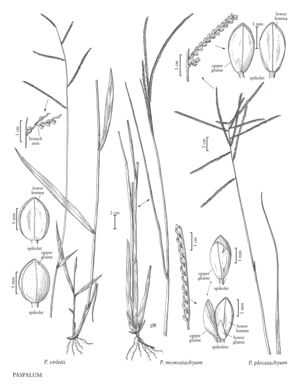Difference between revisions of "Paspalum virletii"
FNA>Volume Importer |
FNA>Volume Importer |
||
| Line 17: | Line 17: | ||
-->{{Treatment/Body | -->{{Treatment/Body | ||
|distribution=Ariz. | |distribution=Ariz. | ||
| − | |discussion=<p | + | |discussion=<p>Paspalum virletii grows in dry, sandy soils in disturbed habits. It is known only from Arizona, where it is considered a rare species, and from Mexico, where it also appears to be either rare or poorly collected (COTECOCA 2000).</p> |
|tables= | |tables= | ||
|references= | |references= | ||
| Line 33: | Line 33: | ||
|basionyms= | |basionyms= | ||
|family=Poaceae | |family=Poaceae | ||
| + | |illustrator=Linda A. Vorobik and Cindy Roché | ||
|distribution=Ariz. | |distribution=Ariz. | ||
|reference=None | |reference=None | ||
| Line 38: | Line 39: | ||
|publication year= | |publication year= | ||
|special status= | |special status= | ||
| − | |source xml=https:// | + | |source xml=https://bibilujan@bitbucket.org/aafc-mbb/fna-data-curation.git/src/314eb390f968962f596ae85f506b4b3db8683b1b/coarse_grained_fna_xml/V25/V25_1486.xml |
|subfamily=Poaceae subfam. Panicoideae | |subfamily=Poaceae subfam. Panicoideae | ||
|tribe=Poaceae tribe Paniceae | |tribe=Poaceae tribe Paniceae | ||
Revision as of 17:16, 30 October 2019
Plants perennial; cespitose. Culms 40-75 cm, erect, not swollen at the base; nodes pubescent. Sheaths pubescent; blades to 15 cm long, 5-10 mm wide, flat, pubescent. Panicles terminal, with 3-8 racemosely arranged branches; branches 2-7 cm, spreading, terminating in a spikelet; branch axes narrow, sparsely pubescent. Spikelets 2-2.5 mm long, 1.4-1.6 mm wide, paired, imbricate, appressed to the branch axes, ovate. Lower glumes absent; upper glumes shortly pubescent, 3-veined, margins entire; lower lemmas glabrous, lacking ribs over the veins, 3-veined, margins entire; upper florets pale to stramineous or golden brown. 2n = unknown.
Discussion
Paspalum virletii grows in dry, sandy soils in disturbed habits. It is known only from Arizona, where it is considered a rare species, and from Mexico, where it also appears to be either rare or poorly collected (COTECOCA 2000).
Selected References
None.
